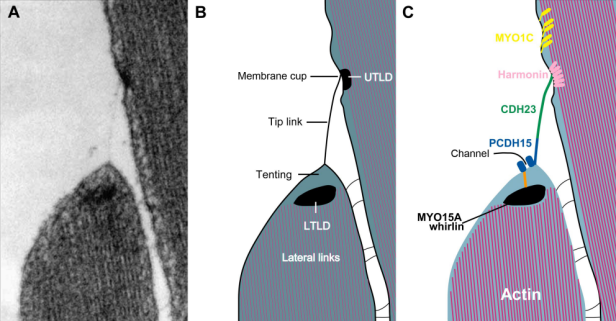Question: As a student getting a degree in music composition, the auditory sense is particularly important to me. But while I have studied both the science behind composition and the science of music and sound, one thing that remains a mystery to me is the science that occurs once sound reaches the inner ear. How does our sense of sound work? What is the molecular pathway that relays auditory signals to the brain?
Answer: Stover and Diensthuber investigated the molecular basis of hearing and determined that the first step is for sound to activate the inner and outer hair cells. These hair cells are sensory cells that transmit sound to the brain. The inner hair cells transmit sensory impulses through the auditory nerve while the outer hair cells select and amplify the signals. These hair cells contain a hair bundle which serves as the initial receptors for the vibrating air that manifests as sound. When the hair bundles move in response to the vibrating air, ion channels within the hair cells open and close . The transduction apparatus that allows for this to happen is based on links between adjacent structures on the individual hair bundles. This link formed by cadherin 23 and protocadherin 15 proteins connects an ion channel found on the tips of one of the stereocilia (an individual hair fiber of the hair bundle) to a membrane cup found along the side of the adjacent stereocilia. This membrane cup is made of harmonin, and is proximal to large quantities of myosin 1c. This linking structure causes the initial signal transduction, as the cadherin and protocadherin links stretch to open potassium and calcium ion channels. This causes an influx of calcium ions, leading to myosin molecules separating from actin filaments in the stereocilia. By doing so, the upper portion of the link, attached to the harmonin, descends, relaxing the link and causing the channel to close, relieving the influx of potassium ions.
As the hair cells move, activating calcium channels, the gradient causes an electrical potential through the synapses of the spiral ganglion, nerve fibers connected to the hair cells. These postsynaptic potentials lead to the activation of glutamate receptors on the spiral ganglion which sends the signal through the nervous system into the brain. This also serves as the site for sound coding. As the sound moves at specific pitches, the hair cells move in response, with particular hair cells responding most to specific pitches. These motions activate the hair cells which activate the neurons in response, transforming the waveform that correlates to a particular pitch and timbre to an auditory signals that registered by the nervous system. For a more in depth analysis on the aforementioned mechanisms, refer to Stover and Diensthuber’s 2011 article “Molecular Biology of Hearing”.

Figure 1: Molecular pathway of initial signal transduction in the hair bundles. From Stover and Diensthuber
- TitoBC
Sources:
- Stover, Timo & Diensthuber, Marc. “Molecular Biology of Hearing.” GMS Current Topics in Otorhinolaryngology, 10 (2011): Web. 23 June 2016. Doi: 10.3205/cto000079

Very informative article. I recently read another article about treating hearing loss by regrowing hair cells: http://www.scientificamerican.com/article/hear-raising-compound-reg/.
LikeLiked by 1 person
Interesting article!
LikeLiked by 1 person